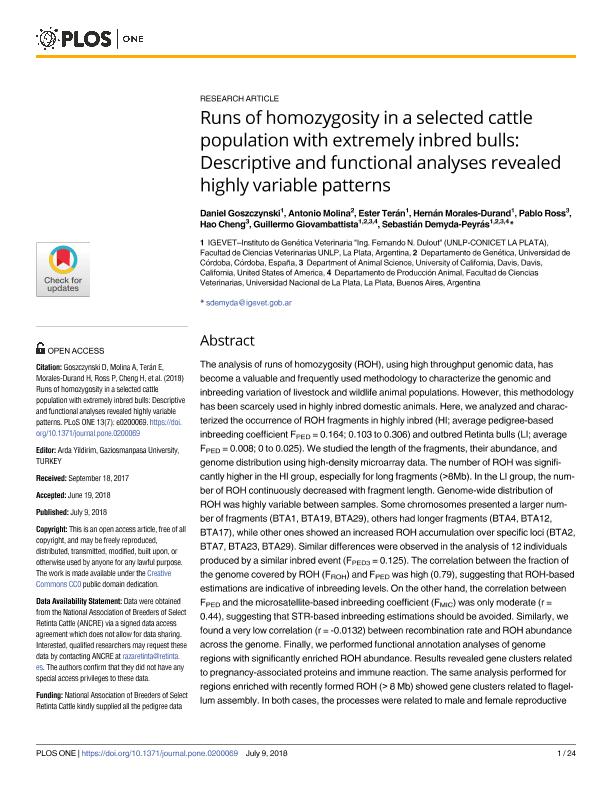Artículo
Runs of homozygosity in a selected cattle population with extremely inbred bulls: Descriptive and functional analyses revealed highly variable patterns
Goszczynski, Daniel Estanislao ; Molina, Antonio; Teran, Ester Mercedes
; Molina, Antonio; Teran, Ester Mercedes ; Morales-Durand, Hernán; Ross, Pablo; Cheng, Hao; Giovambattista, Guillermo
; Morales-Durand, Hernán; Ross, Pablo; Cheng, Hao; Giovambattista, Guillermo ; Demyda-Peyrás, Sebastian
; Demyda-Peyrás, Sebastian
 ; Molina, Antonio; Teran, Ester Mercedes
; Molina, Antonio; Teran, Ester Mercedes ; Morales-Durand, Hernán; Ross, Pablo; Cheng, Hao; Giovambattista, Guillermo
; Morales-Durand, Hernán; Ross, Pablo; Cheng, Hao; Giovambattista, Guillermo ; Demyda-Peyrás, Sebastian
; Demyda-Peyrás, Sebastian
Fecha de publicación:
07/2018
Editorial:
Public Library of Science
Revista:
Plos One
ISSN:
1932-6203
Idioma:
Inglés
Tipo de recurso:
Artículo publicado
Clasificación temática:
Resumen
The analysis of runs of homozygosity (ROH), using high throughput genomic data, has become a valuable and frequently used methodology to characterize the genomic and inbreeding variation of livestock and wildlife animal populations. However, this methodology has been scarcely used in highly inbred domestic animals. Here, we analyzed and characterized the occurrence of ROH fragments in highly inbred (HI; average pedigree-based inbreeding coefficient FPED = 0.164; 0.103 to 0.306) and outbred Retinta bulls (LI; average FPED = 0.008; 0 to 0.025). We studied the length of the fragments, their abundance, and genome distribution using high-density microarray data. The number of ROH was significantly higher in the HI group, especially for long fragments (>8Mb). In the LI group, the number of ROH continuously decreased with fragment length. Genome-wide distribution of ROH was highly variable between samples. Some chromosomes presented a larger number of fragments (BTA1, BTA19, BTA29), others had longer fragments (BTA4, BTA12, BTA17), while other ones showed an increased ROH accumulation over specific loci (BTA2, BTA7, BTA23, BTA29). Similar differences were observed in the analysis of 12 individuals produced by a similar inbred event (FPED3 = 0.125). The correlation between the fraction of the genome covered by ROH (FROH) and FPED was high (0.79), suggesting that ROH-based estimations are indicative of inbreeding levels. On the other hand, the correlation between FPED and the microsatellite-based inbreeding coefficient (FMIC) was only moderate (r = 0.44), suggesting that STR-based inbreeding estimations should be avoided. Similarly, we found a very low correlation (r = -0.0132) between recombination rate and ROH abundance across the genome. Finally, we performed functional annotation analyses of genome regions with significantly enriched ROH abundance. Results revealed gene clusters related to pregnancy-associated proteins and immune reaction. The same analysis performed for regions enriched with recently formed ROH (> 8 Mb) showed gene clusters related to flagellum assembly. In both cases, the processes were related to male and female reproductive functions, which may partially explain the reduced fertility associated with inbred populations.
Palabras clave:
Roh
,
Cattle
,
Inbreeding
Archivos asociados
Licencia
Identificadores
Colecciones
Articulos(IGEVET)
Articulos de INST.DE GENETICA VET ING FERNANDO NOEL DULOUT
Articulos de INST.DE GENETICA VET ING FERNANDO NOEL DULOUT
Citación
Goszczynski, Daniel Estanislao; Molina, Antonio; Teran, Ester Mercedes; Morales-Durand, Hernán; Ross, Pablo; et al.; Runs of homozygosity in a selected cattle population with extremely inbred bulls: Descriptive and functional analyses revealed highly variable patterns; Public Library of Science; Plos One; 13; 7; 7-2018; 1-24
Compartir
Altmétricas



